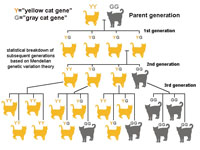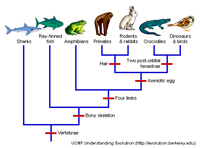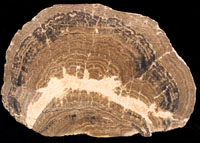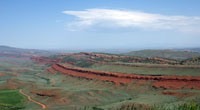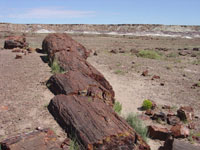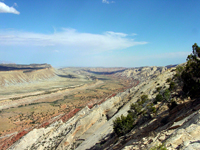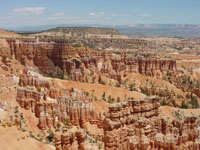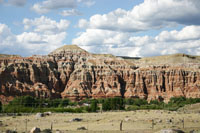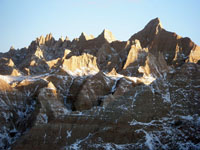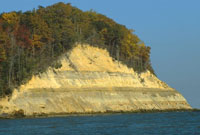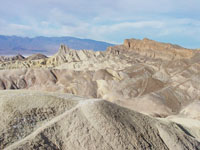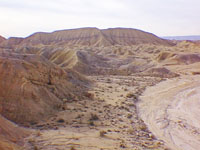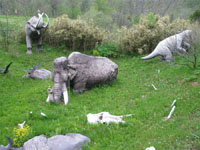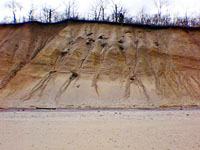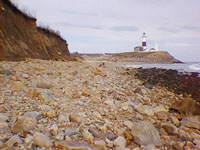
Introduction to Oceanography |
Chapter 2 - Evolution of Life Through Time |
| This chapter is a brief summary of the evolution of life on Earth through time. Historical geology is the science that examines concepts of evolution and geologic time as preserved in the fossil record. Historical geology is relevant to all other sciences that involve studies of the physical environment!. This chapter is a very brief summary of the history of life and discussions about some major geologic events shaping planet Earth. Figure 2-1 highlights many of the key geological and biological events that occurred, impacting life, leading to the present. Earth formed from the accumulation of dust, gases, asteroids, and small planetesimal in the stellar nebula (as discussed in Chapter 1). During this early period in Earth history conditions on the surface of the planet were probably too hot for oceans to exist. However, over time the surface cooled enough for oceans to form and persist. However, the oceans and atmosphere were chemically very different than what exists today. The Early Earth had no significant free oxygen in the air or oceans, and the oceans were rich in organic compounds, essential for the development of evolution and life. The oldest sedimentary rocks on Earth preserve evidence of biological activity, but only on a primitive microbial level. Early evolution was taking place on the molecular, intercellular, and microbial scales for the first 3 billion years of Earth's history. Eventually primitive life forms began to use photosynthesis as a source of energy, and gradually (over a billion years) the atmosphere and oceans became an oxygen-rich environment allowing more complex life forms to evolve. |
Click on thumbnail images for a larger view. |
 Fig. 2-1. Geologic Time Scale with highlights in evolution and events in Earth history. |
What Do All Living Organisms Have In Common?
|
Origin of All Living Things On EarthThe age of the Earth within the Solar System is in the range of +4.5 billion years. The oldest rocks that preserve fossil evidence of life have been discovered in Australia and Africa that date to around 3.5 billion years, with traces of possible organic residues dating back as much as 4.2 billion years. Biologists use the term abiogenesis to describe the natural processes by which life has arisen from non-living matter composed of simple organic compounds. Life functions though the interactions of carbon compounds including lipids, carbohydrates, and amino acids. These compounds are essential for the cell membranes, movement of internal fluids for respiration, manufacture of proteins, and self-replicating molecules (nucleic acids: DNA and RNA). The big questions yet to be resolved is whether all living things on Earth evolved from a common primordial ancestor (or ancestors) here on our planet, or whether life came to Earth from and extraterrestrial sources (suggesting that evolution of living things may be widespread throughout the galaxy and beyond). |
Key Developments In Understanding the Origin Of Life On Earth |
EvolutionEvolution means (in general usage) the gradual development of something, especially from simple to more complex forms. In biological sciences, evolution involves the processes by which different kinds of living organisms are thought to have developed and diversified from earlier forms during the history of the Earth.Biological evolution also involves changes in heritable genetic traits within biological populations over successive generations (first described by Gregor Johann Mendel in 1865). Evolution occurs at many scales including the molecular level, cell level, organism level, species level, and ecosystem community level. Biologists and paleontologist have been studying how different species of plants, animals, and microorganisms are related to each other for centuries. Taxonomy is the science of naming, describing and classifying organisms and includes all plants, animals and microorganisms. The Linnaeus's system of classification is used to group organisms. Figure 2-6 illustrates how living things are classified based on shared or identifying characteristics. Figure 2-7 illustrates the hierarchical classification of living things, subdivided into increasingly smaller groups down to the individual species. From largest group downward the order is as follows: kingdom, phylum, class, order, family, genus, species, and subspecies. To illustrate, Figure 2-8 illustrates the taxonomic classification of a common house cat (Felis catus). Note that the name of an organism is always written with a genus and species name, written in italics. Most familiar animals and plants have a common name (that is not written in italics). Figure 2-9 illustrates the classification of dogs (down to the subspecies name. Note that both cats and dogs both fall within the classification within the order Carnivora (meaning carnivores). This classification suggests that all organisms classified as Carnivora share common traits that link them to their ancestral heritage. |
EvolutionEvolution means (in general usage) the gradual development of something, especially from simple to more complex forms. In biological sciences, evolution involves the processes by which different kinds of living organisms are thought to have developed and diversified from earlier forms during the history of the Earth.Biological evolution also involves changes in heritable genetic traits within biological populations over successive generations (first described by Gregor Johann Mendel in 1865). Evolution occurs at many scales including the molecular level, cell level, organism level, species level, and ecosystem community level. Classification Of Living Things Linked To Evolution Through Geologic TimeThe evolutionary "Tree of Life" is a graphical or hypothetical conceptualization that links all species back to their deep ancestral heritage, far back in geologic time, to a common ancestral origin billions of years ago. For instance, Figure 2-10 illustrates an example of the Tree of Life presented by an organization of research scientists called OneZoom. Biologist, paleontologist, and other scientists have been classifying, and reclassifying species now for hundreds of years. Current thought is that there is roughly 8.7 million species of plants and animals in existence, but that number is constantly changing. |
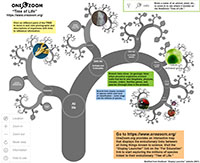 Fig. 2-10. The evolutionary "Tree of Life" as illustrated by https://www.onezoom.org/. Click the link to explore the the details an exhaustive classification of all known living things, including of millions of organisms (species) illustrated. |
Evolutionary Theory HighlightsEvolutionary theory is a an essential component of the knowledge supporting the current geologic time scale. |
| Populations that evolve in separate settings may develop similar traits (convergence)
|
How Evolution WorksThe life mission of individuals in any species is to eat, survive, and reproduce (Figure 2-11).While living, individuals must deal with competition (within a population of their own species, or with other species). Individuals must also adapt to environmental changes (changes in living space, availability of food resources, climate changes, catastrophes, etc.). As time passes, species with either adapt to changing situations (and evolve), or they face die offs or extinction. |
 Fig. 2-11. How evolution works. Fig. 2-11. How evolution works. |
All species have a role within an ecosystem.The term niche refers to the specific area inhabited by an organism. The term niche also refers to the role or function of a species within an ecosystem, involving the interrelationships of a species with all the biotic and abiotic factors affecting it. All species fill a niche, ranging from limited, small micro-environments to a distribution on a regional or even global scale in a multitude of environmental settings. |
|
Essential Concepts of Historical Geology & EvolutionThe geologic time scale is a systematic and chronological organization of time related to the history of the Earth and Universe used by scientists (geologists, paleontologists, astronomers) to describe the timing and relationships between events that have occurred (see Figure 2-1).Paleontology is the scientific study of life forms existing in former geologic periods, as represented by their fossils; the science involves reconstructing the physical characteristics of organisms, life habits, and the environments where they lived (paleoecology). A fossil is a remnant or trace of an organism of a some earlier geologic age, such as a skeleton or leaf imprint, embedded and preserved in sedimentary deposits. Few things living today will survive to become fossils (see table to right on how fossils form). The term fossil record is used by geologists and paleontologists (scientists who study paleontology) to refer to the total number of fossils that have been discovered, as well as to the information derived from them. Many species that we see today do not get a chance to be preserved as fossils, but we can still learn about them by comparing them to fossils that have been found and properly recorded. Fossilization is the processes that turn plant or animal remains eventually to stone. The table to the right reviews how something survives destruction to become a fossil. A trace fossil is a fossil impression of a footprint, trail, burrow, or other trace of an animal rather than of the animal itself. Sedimentary rocks often display an abundance of traces of how organisms interacted with their environment. |
Review of how fossils form |
| After an organism dies, its remains must: 1. survive being eaten (at least partially eaten). 2. must survive transport to site of preservation. 3. survive burial in sediments or volcanic materials. 4. survive bioturbation (being chewed up underground by burrowing organisms). 5. survive microbial decay. 6. survive compaction with burial. 7. survive chemical changes associated with lithification. 8. survive uplift, weathering and erosional exposure. 9. be discovered and identified. 10. be researched, reported, and curated to be useful. |
Sedimentary Sequences Preserve the Fossil RecordThe history of the evolution of life is partly preserved in sedimentary rocks found around the world. The ancient history of a species is also preserved in the DNA of living organisms. Although the fossil record is extensive, there are many gaps in the fossil record where sediments of different ages have not been preserved in many regions, and much has been erased as ocean crust is destroyed in the processes involving plate tectonics (discussed in Chapter 4). Also, ancient sedimentary deposits on continental are destroyed by erosion. Despite these issues, sedimentary deposits representing all geologic ages are preserved and exposed in different places around the world. The fossil record is best preserved and represented by sedimentary deposits associated with ancient shallow marine and coastal environmental settings preserved and exposed in continental settings.Transgressions and Regressions of Ancient Shallow SeasFigure 2-12 shows how sea level rose and fell through the ages across North America. A transgression occurs when sea levels rise and shallow seas advance onto the margins of a continent. When sea level falls, the seas retreat and land is exposed—a process called a regression. For much of the last billion years shallow seaways transgressed onto the North American continent. Many minor transgressions and regressions also occurred, and shallow seas intermittently covered large portions of the continent. When sea level rose, sediments were deposited blanketing large regions of the continents. These deposits are preserved as sedimentary rock formations that accumulated in terrestrial, coastal, and marine depositional environments. Groups of these rock formations are parts of sedimentary sequences that preserve the fossil record. |
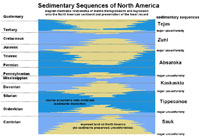 Fig. 2-12. Major sedimentary sequences of North America preserve some of the evidence of the fossil record (after Sloss, 1931). The Sauk Sequence is the oldest containing shell fossils of the Cambrian Period. Each sequence represents a major advance (transgression) of shallow seas and coastal environments. Major unconformities represent periods of regression (dominated by erosion when the seas withdrew). |
 Fig. 2-13. Paleozoic-age sedimentary sequences exposed in the Grand Canyon, Arizona include portions of the Sauk, Tippecanoe, Kaskaskia, and Absaroka sequences (shown in Figure 2-13). Each sequence is bounded (above and below) by unconformities. The oldest sequence bearing an abundance of fossils is the Sauk Sequence that rests on top of the Great Unconformity, an erosional boundary between rocks of Precambrian and Cambrian age exposed in the deepest parts of the Grand Canyon. |
Ecological Succession: How Species and Ecosystem Populations Change Over Time |
| Studies of the fossil record show that extinctions in Earth's history vary from a disappearance of a species (an extinction), to the disappearance of entire lineages and populations within regional communities or globally (a mass extinction). Paleontologist have scoured outcrop areas and made extensive collection of fossils. Their investigations have revealed information about the appearance, changes, and extinction of many species. In many cases, they have made detailed analysis of fossil population and distributions across a region where rock layers of a particular age are preserved—one example involves extensive in sedimentary rock formations like the Triassic-age Chinle Formation in Painted Desert region of Arizona that contain an abundance of well preserved fossils (Figure 2-14). The changes in species structure of an ecological community over time is called ecological succession. Ecological succession takes place on time scales ranging from decades (such as what happens to forest community after a massive wildfire or catastrophic superstorm) or even millions of years during an ice age or a mass extinction event. Figure 2-15 shows an interpretation of the changes in the species populations in within an ancient ecosystem over time as revealed by fossils preserved is successive layers of sedimentary strata. Changes in ancient species populations and ecosystems can be inferred from the abundance the fossil preserved (or missing), the character of the fossils themselves, and sometimes information can be inferred from the sediments surrounding fossils or trace fossils in the sedimentary layers investigated in a study area. Studies show that species appear, populations grow, and then decline and vanish, sometimes returning, or are often replaced by other species that either have out-competed them, or simply replaced them when climate changes or other processes occurred that changed an ecosystem community setting over time. |
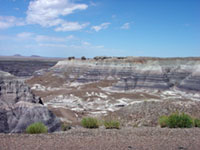 Fig. 2-14. Outcrop area of the Triassic-age Chinle Formation in the Painted Desert, Arizona is an example of an ideal study area that has an abundance of fossils preserved in many layers of strata over a large region. Layers of strata that contain fossils are commonly called fossil beds. |
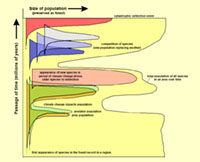 Fig. 2-15. Population changes in a local ecosystem over time (showing population curves for select species and total population of all species observed preserved in fossil beds). Interpretations like this may be made from exhaustive studies of fossil collections from an area like in Figure 2-14. |
Geologic History and Biological EvolutionThe following sections of this chapter is a review of major geologic events, biological evolution, and selected important concepts related to Earth history, starting with the most ancient events and appearance of life forms in the fossil record and leading to the Present. |
Precambrian Eon |
Precambrian is the general name for the geologic time period between when the Earth formed in the Solar System (in Hadean Time about 4.56 billion years ago) and the beginning of Phanerozoic Eon (about 540 million years ago). The oldest rock on Earth are Precambrian age. The Precambrian is subdivided into three Eons: • Hadean Eon (before about 4 billion years ago) • Archean Eon (between about 4.0 and 2.5 billion years ago) • Proterozoic Eon (between about 2.5 billion and 540 million years ago). The Precambrian encompassed all of early Earth history and rocks from that time preserve evidence of the evolution of life forms on a microbial level. In biology, cell theory states that a cell is the fundamental structural and functional unit of living matter, and that the an organism a multicellular body composed of autonomous cells with its properties being the sum of those of its cells. Multicellular organisms (animals and plants) do not appear in the fossil record until late in Precambrian (Late Proterozoic) time. The Phanerozoic Eon began after the end of the Proterozoic Eon about 540 million years ago, and marks the change when fossil remains of multicellular organisms began to appear in great abundance in the fossil record (discussed below). |
| Geologic Time | Highlights of Biological Evolution | 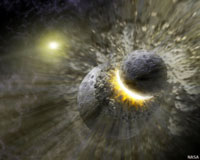 Fig. 2-16. Current thought is that the Moon formed from the debris created by the collision of a small planet-sized object with the ancestral Earth (or Proto Earth) early in the history of the Solar System about 4.5 billion years ago. |
|
P |
About 4.56 billion years ago | Formation of Earth and Moon within the Solar System nebula (Figure 2-16). (This is discussed in detail in Chapter 1). This event occurred before life is known to evolve on Earth. | |
| About 4 billion years ago | Evidence of earliest cell-based life of Earth (prokaryotes). | ||
| About 3 billion years ago | Evidence of photosynthesis and first eukaryotic cells capable of oxygen-based respiration. | ||
| About 3.0 to 1.8 billion years ago | World-wide deposition of banded-iron formations fundamental to the gradual conversion of Earth atmosphere rich in carbon dioxide (CO2) to oxygen (O2) (discussed below). This conversion took nearly a billion years. Once there was enough free oxygen in the atmosphere, this allowed the development of an ozone layer to protect Earth from deadly solar ultraviolet radiation (UV). UV destroys many organic organic compounds. Without an ozone layer, intense solar UV probably would have killed life in the shallow ocean waters. | ||
| About 1.8 billion years ago | Sexual reproduction fully established in eukaryotes. Sexual reproduction increased the rate of mutation in species, leading to increased biodiversity. | ||
| About 1 billion years ago | Earliest evidence of multicellular organisms (metazoans). Early multicellular organism were very primitive but diversified very quickly through geologic time. | ||
| P H A N E R O Z O I C E O N ⬇︎ |
Cambrian Period Beginning about 540 million years ago |
The beginning of the Cambrian Period started a radiation of species preserved in the fossil record. This is, in-part, because many organisms began to develop the first hard skeletal material as part of defensive and functional body plans. The diversity of species preserved in Cambrian sediments is partly because soft-bodied organisms were not preserved in Precambrian-age sediments. Significant changes happened in the global physical environment in Cambrian time. Formation of the ozone layer created hospitable habitats and new space for organisms to move up and utilize shallow, warm sea environments that followed a major transgression onto the continents. Organisms were finally able to adapt to this new environment by allowing them to utilized calcite (CaCO3) for hard body parts are (shells and exoskeletons). Organisms with calcareous body parts were selectively or preferentially preserved in Cambrian and younger sedimentary rocks. The selective preservation of calcareous body parts has therefore made it easier to find evidence of life forms today preserved as fossils. Sediments composed of the skeletal remains of organisms (with shells and exoskeletons rich in CaCO3) is called lime, which turns into a sometimes quite fossiliferous rock, limestone. |
|
Early Evidence of Life on a Global ScaleBanded-iron formations (BIFs) are sedimentary mineral deposits consisting of alternating beds of iron-rich minerals (mostly hematite) and silica-rich layers (chert or quartz) that formed about 3.0 to 1.8 billion years ago (Figure 2-17). Theory suggests BIFs are associated with the capture of free oxygen released by photosynthetic processes by iron dissolved in ancient ocean water. The ancient oceans were enriched in CO2 (just like the atmosphere). Iron easily dissolves in CO2-rich water — this is easy experiment to illustrate: drop and iron nail in a bottle of soda and it will dissolve completely in a few days! The early oceans must have been rich in iron (similar to salt is today)! Once nearly all the free iron dissolved in the ancient seawater was consumed, oxygen could gradually accumulate in the atmosphere. Once enough oxygen was free in the atmosphere, an ozone layer could form.BIF deposits of Precambrian age are preserved in many locations around the world, occurring as massive and widespread deposits, hundreds to thousands of feet thick. The BIFs we see today are only remnants of what were probably every greater and more extensive deposits. During Precambrian time, BIF deposits probably extensively covered large parts of the ancient global ocean basins. Today, BIFs are the major source of the world's iron ore and are found preserved on all major continental shield regions. |
 Fig. 2-17. A sample of Precambrian banded-iron formation (BIF) from Fremont County, Wyoming. |
Cell Theory in EvolutionCell Theory dictates that all known living things are made up of one or more cells (the fundamental structure and functioning living unit in all living things. All living cells arise from pre-existing cells by processes involving cell division.Cells are divided into two main classes: prokaryotic cells and eukaryotic cells.Prokaryotic cells include (bacteria and related organisms). Prokaryotes lack a nucleus (or nuclear envelope) and are generally smaller, structurally simpler, and less complex genomes (genetic material) than eukaryotic cells (Figure 2-17).Eukaryotic cells contain cytoplasmic organelles or a cytoskeleton, and contain a nucleus in which the genetic material is separated from the cytoplasm. Eukaryotes include fungi, plants, animals, and some unicellular organisms. Eukaryotic cells are capable of sexual reproduction (Figure 2-18). The oldest known prokaryote fossils are about 3.5 billion years old. The oldest known eukaryote fossils are about 1.5 billion years old. The same basic molecular processes are involved in the lives of both prokaryotes and eukaryotes, suggesting that all present-day cells are descendant from a single primordial ancestor. Endosymbiosis is a theory that suggests organelles evolved in eukaryotic cells and occurred when one type of cell became incorporated into another type of cell, creating a symbiotic relationship to the benefit of both (such as chloroplasts in plants, and mitochondria in animals). Viruses are non-living organic structures capable of genetic self replication that are not classified as cells and are neither unicellular nor multicellular organisms; viruses lack a metabolic system and are dependent on the host cells that they infect to reproduce. Viruses likely have influenced evolution on a cellular level in Precambrian time, just as they impact species evolution today. A stromatolite is a mound of calcareous sediment built up of layers of lime-secreting cyanobacteria (blue-green bacteria, algae and other more primitive eukaryotic life forms) that trap sediment, creating layers accumulations (Figure 2-19). Stromatolites are found in Precambrian rocks and represent some of the earliest known fossils. Stromatolites are known from all geologic time periods and are still occurring today, with exceptional examples resembling ancient life forms still being formed today in places like Shark Bay, Australia (Figure 2-20). Life in Late Precambrian Time (Late Proterozoic Eon)Evidence of the first sexual reproduction appear in the fossil record about 1.2 billion years ago. Many eukaryotic organisms including protista (both unicellular and colonial forms), fungi, and multicellular organisms (including plants and animals) reproduce sexually.Metazoans are multicellular animals that have cells that differentiate into tissues and organs and usually have a digestive cavity and nervous system. Metazoans appeared on Earth in Late Precambrian time (Late Proterozoic Eon) consisting of cells that with growth would differentiated into unique tissue or organs used for special purposes, such a locomotion, feeding, reproduction, respiration, tissues able to sense the environment, etc. Late Precambrian life forms have been discovered, but fossils from this period are scarce and poorly preserved because they did not contain hard parts (skeletons, teeth, etc.). Impression is sediments are dominantly trace fossils (tracks, trails, resting and feeding traces) and rare body impressions have been found. A group of ancient fossil organisms called the Ediacaran fauna is one of the earliest known occurrence of multicellular animals is the fossil record. They were named for the Ediacaran Hills of South Australia where they were first discovered. Traces of Ediacaran fauna has been found worldwide in sedimentary rocks of about 635 to 541 million years (very late Precambrian age) and consisted of frond- and tube-shaped, soft-body organisms, mostly sessile life forms (sessile meaning attached to the seabed). Many of the fossils from this time period share similar characteristics of some families or classes of organisms still found on Earth today (including segmented worms, jellyfish, chordates, and other invertebrates). |
|
The Paleozoic EraThe Paleozoic is the era of geologic time spanning about 541 to 248 million years ago. Paleozoic means ancient life (even though evidence of microbial life extends well back in time to some of the earliest sedimentary rocks still preserved and discovered on Earth). The Paleozoic Era follows the Precambrian Eon and precedes the Mesozoic Era. The term Paleozoic is used to describe the age of rocks that formed and accumulated in that time period. Highlights include:• Dominant large animals: Invertebrates dominate early; fish and amphibians appear in the middle Paleozoic, and reptiles appear even later. • Continents were mostly clustered together throughout the Paleozoic Era. • Large, warm, clear, shallow seas covered large portions of continents. • Similar animal and plant species existed on each continent. • Continents were mostly low with little relief. Few large mountain ranges existed on and around most continental landmasses (compared with today). • The combined Appalachians and Atlas Mountains formed 350 to 400 MYA (between what was North America and Africa before the opening of the Atlantic Ocean basin). |
Highlights of the Early Paleozoic EraEvolution of early plant and animal life (dominated mostly marine invertebrates) is revealed in the fossil record of the early part Paleozoic Era. Primitive land plants, insects, and the first vertebrates also appear. |
Cambrian Period (540-485 million years)The Cambrian Period is the oldest of the named geological periods of the Paleozoic Era. At the beginning of the Cambrian Period the combination of tectonic forces and erosion of the landscape allowed shallow seas to gradually cover much of North America. Shallow seas covered most of what is now the Great Basin, Rocky Mountains, and Great Plains in the west, and much of East Coast, Appalachian region, and most of the Midwest. The shallow seas withdrew at the end of Cambrian time, but what was left behind was a blanket of Cambrian sedimentary rocks, collectively called the Sauk Sequence (see Figures 2-21 and 2-22, also see Figure 2-12). The base of the Sauk Sequence rests on an eroded surface of ancient Precambrian-age (mostly metamorphic and igneous rocks of the core of more ancient mountain systems). This sequence boundary is called the Great Unconformity. The Great Unconformity is exposed in many places throughout the western United States, and is particularly well known from exposures along the base sedimentary rocks of Cambrian age exposed in the Grand Canyon within the canyons Inner Gorge (see Figure 2-13). The Great Unconformity can be traced across most of North America wherever the base of the Cambrian-age Sauk Sequence is exposed.Calcareous skeletal shell remains first appear in the Cambrian Period.The term Cambrian explosion refers to evidence in the fossil record which shows that all major phyla were established in the transition from latest Precambrian to the Early Cambrian Period (about 700 to 541 million years ago) (Figure 2-23). The cause of this radiation from earlier metazoan life forms is uncertain, but it may have been driven by global climate changes (hot to cold cycles) and the establishment of unique habitats (niches) which allowed species to evolve separately from common ancestors. In Cambrian time, escalation of predator-prey relationships and increased competition appears to have driven rapid evolution of new species (along with extinctions). In Cambrian time, shelled organisms first appear in abundance in sedimentary deposits preserved from that time period. The fossil record from Cambrian time show that organisms with chitonous and calcareous shells and exoskeletons appeared and diversified. Many Cambrian-age organisms have eyes, legs (or pods), spinal chord-like features, segmented body plans, and other unique body parts and characteristics. Representatives of all phyla from the Cambrian Explosion still exist in the world today (Figure 2-23). Sedimentary rocks from Cambrian Period are typically rich in evidence of life activity. They preserve an abundance of bioturbation features (also called trace fossils) even if the life forms that created them are not preserved (an example of bioturbation [trace fossils] is shown in Figure 2-24).Invertebrates dominate the fossil record in the early Paleozoic Era. An invertebrate is an animal lacking a backbone (spinal column or spinal chord), such as an arthropod, mollusk, annelid worm, coelenterate, echinoderm, and many others. The classification of invertebrates constitute a division of the animal kingdom, comprising about 95 percent of all animal species and about 30 different known phyla. By the end of the Cambrian Period several groups of invertebrates were well established in shallow marine environments, perhaps most notably were trilobites, brachiopods, crinoids, bryozoans, sponges, and gastropods (snails) are locally common fossils preserved in Cambrian sedimentary rocks (Figures 2-25 and 2-26). At the end of the Cambrian Period, sea level fell and a long period of exposure and erosion occurred throughout North America and the other continents worldwide. |
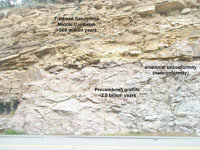 Fig. 2-21. The Great Unconformity is an erosional boundary at the base of the Sauk Sequence throughout much North America. This view is in Wind River Canyon, Wyoming. 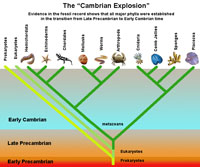 Fig. 2-23. The Cambrian explosion refers to the diversification of life forms that began near the end of the Precambrian Eon. Fig. 2-23. The Cambrian explosion refers to the diversification of life forms that began near the end of the Precambrian Eon.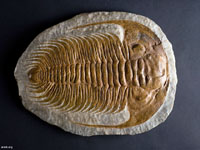 Fig. 2-25. Trilobites are common shelled fossils in sedimentary rocks from the Cambrian Period. |
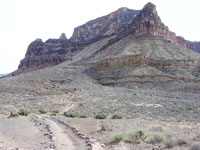 Fig. 2-22. The fossiliferous Bright Angel Shale of Cambrian age is one of the rock formations of the Sauk Sequence exposed throughout the Grand Canyon region.  Fig. 2-24. Invertebrate tracks and trails appear in abundance in Cambrian-age sediments (Tapeates Sandstone) in the lower Grand Canyon in Arizona. 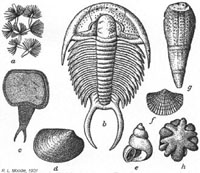 Fig. 2-26. Cambrian fossils: trilobites, brachiopods, gastropods, and other invertebrates |
Ordovician Period (485-444 million years)Shallow seas once again flooded across much of North America through much of the Ordovician Period. Deposition of sediments during this marine transgression resulted in the Tippecanoe Sequence which rests unconformably on top of the Sauk Sequence (see Figure 2-13). However, when sea level rose again (millions of years later) and shallow seas returned to cover large portions of the continents, communities of life forms in the oceans had significantly changed.Trilobites no longer dominated the fossil record, but other life forms began to proliferate in warm, shallow marine environments. Communities similar to some modern reef-like settings appear in the fossil record. Corals (unrelated to modern varieties), crinoids, cephalopods, brachiopods, bryozoans and other fossil life forms with calcareous skeletons dominate the fossil record. Their abundance reflects their ability to live, proliferate, and upon death, survived burial and fossilization processes). Rare early examples of jaw-less, armored fish and land plants have been discovered in sediment deposits of Ordovician age. Sedimentary rocks of Ordovician age crop out in many locations around the country, but they are perhaps best known from the Cincinnati Arch region (of Ohio, Kentucky and Indiana) where a great abundance of well preserved fossils occur in strata preserved from that time period (Figures 2-27 to 2-29). |
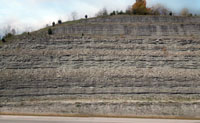 Fig. 2-27. Fossil-rich sedimentary rocks of the Tippecanoe Sequence are perhaps most famous from the Cincinnati Arch region. 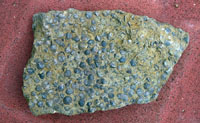 Fig. 2-28. Fossil brachiopods preserved on a layer of Ordovician limestone from Brookville Indiana (on the Cincinnati Arch). |
 Fig. 2-29. Common fossils of the Ordovician Period include brachiopods (a,b), cephalopods (c,d), trilobites (e), and crinoids (f). |
Silurian Period (444-419 million years)Few rocks of Silurian age are preserved in North America's fossil record (they are either not preserved or are not exposed at the surface). Some sedimentary rocks of Silurian age are preserved in upstate New York, around the Cincinnati Arch, and around the margins of the Michigan Basin are notable exceptions. Large fossil pinnacle reefs occur around the margins of an ancient sea basins that covered what is now the state of Michigan. The fossil record shows that the Silurian world was dominated by marine invertebrates, but the first fish-like chordates appear. Simple and primitive forms of land plants began to flourish and diversify during Silurian time. Plants on land became a food source allowing the first animals to emerge onto dry land (including early insects,arachnids and centipedes, and scorpions)(Figure 2-30). The first jawed fishes and freshwater fishes appear in Silurian. Large marine, scorpion-like creatures called eurypterids grew up to nearly 7 feet long (much larger than anything like it that exists like them today). Early vascular plants evolved in the Silurian Period, setting the evolutionary stage for terrestrial swamp and forest ecosystems that followed in geologic time. |
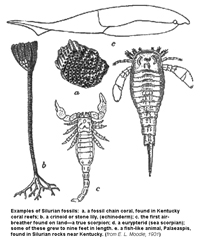 Fig. 2-30. Common and unusual fossils of the Silurian Period. |
Highlights of the Middle and Late Paleozoic EraThe Middle to Late Paleozoic Era is highlighted by the development of forest ecosystems and the development of vertebrate species on land, and rise of large fish in the oceans. |
Devonian Period (419 to 359 million years)On land, free-sporing vascular plants adapted and spread across the landscape, allowing the first forests to cover the continents. By the middle of the Devonian several groups of plants had evolved leaves and true roots, and by the end of the period the first seed-bearing plants appeared. Terrestrial arthropods began to flourish. In the marine world, early ray-finned and lobe-finned bony fish and sharks appear and flourish as revealed in the fossil record. The first coiled-shelled ammonoid mollusks appeared. Holdover families of marine invertebrates from earlier times persisted, including trilobites, brachiopods, cephalopods, and reef-forming tabulate and rugose corals flourished in shallow seas (Figure 2-31).The current oil and gas boom in the United States is largely because of the fracking technologies used to extract petroleum from the tight (meaning low permeability), black shales associated with organic-rich muddy sediments deposited in inland seas of Devonian and Mississippian age. These black shales underlie large regions of the Appalachians, the Mid continent, and northern Great Plains regions in the United States. These deposits are part of the Kaskaskia Sequence (see Figure 2-13). |
 Fig. 2-31. Devonian Period brachiopods and common fossils from Kentucky. |
Carboniferous Period (359 to 299 million years ago)The Carboniferous Period got its name from the abundance of coal deposits in rocks of Late Paleozoic age in Europe. In the United States, the Carboniferous Period is subdivided into the Mississippian Period and Pennsylvanian Period. An abundance of coal deposits of these ages also exist in eastern and central United States. During the Carboniferous the world was very different than today. The Earth's atmosphere was much thicker, having as much as 40% more oxygen and a more uniform global environment than exists today by some estimates. |
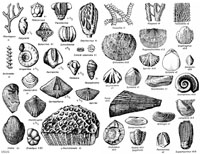 Fig. 2-32. Mississippian Period marine invertebrate fossils from Pennsylvania. 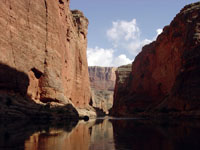 Fig. 2-33. The massive Redwall Limestone of Marble Canyon and the Grand Canyon formed in the Mississippian Period. |
Mississippian Period (359 to 323 million years ago)Sedimentary rocks of Mississippian age in North America are dominated by marine sediments preserved as limestones rock formations when shallow, warm seas covered much of North America. Massive fossiliferous limestone rock formations of Mississippian age exposed throughout the Midcontinent (Mississippi Valley), and throughout the Appalachian and Rocky Mountain regions (Figure 2-32). For example, the Redwall Limestone in the Grand Canyon region is about 800 feet thick (Figure 2-33). Mississippian rocks throughout these regions are host to many cavern systems (such as Mammoth Cave in Kentucky). Mississippian rocks are part of the Kaskaskia Sequence (see Figure 13-16).The southern Appalachian Mountains began to rise in Mississippian time, and terrestrial lowlands and coastal swamps began to replace shallow seas that covered much of the North American continent at that time. Coastal swamps along the margins of rising mountain ranges rising above the shallow seas began to support forests. Amphibians became the dominant marginal-land vertebrates in Mississippian time. Amphibians require water to lay their eggs. This is true for amphibians found around the world. Today there are only freshwater and terrestrial species (there are no marine amphibian species). |
Pennsylvanian Period (323 to 299 million years ago)The Pennsylvanian Period is named for the coal-bearing region in the Appalachian Plateau and Mountains region). Great coastal forests and swamplands covered large regions of North America and parts of Europe. Great coal deposits formed from extensive swamps that trapped organic sediments in locations around the world. Pennsylvanian rocks are perhaps best know for their coal-bearing basins in the Appalachians and Midwest regions (Figures 2-34 and 2-35). These ancient swamp forests deposits are mined as the source coal from rock formations in West Virginia, Kentucky, Pennsylvania, and Ohio, and other states.Perhaps the greatest evolutionary innovation of the Carboniferous Period was the development of amniote egg which allowed lizard-like tetrapods to advance. Reptiles evolved and became the first totally terrestrial vertebrates, descendant from amphibian ancestors. With the abundance of vegetation on land, arthropods flourished, including species of insects that are much larger than any found on Earth today (Figure 2-31). In Pennsylvanian time, glaciation cycles in the Southern Hemisphere caused repetitious rise and fall in sea levels. The Appalachian and Ouachita Mountain systems also began to develop as ancient forms of the continents of Africa, South America, and North America began to collide with one-another. It was during the Pennsylvanian Period that the world's continents assembled together to form the supercontinent of Pangaea (discussed in Chapter 4). The unconformable boundary between the Kaskaskia Sequence and the overlying Absaroka Sequence is the boundary between sedimentary rocks Mississippian and Pennsylvanian age (see Figure 2-13).The Absaroka Sequence includes sediments deposited during Pennsylvanian, Permian and Triassic Periods (see below). |
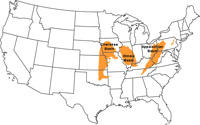 Fig. 2-34. Pennsylvanian age coal-bearing basins in the eastern United States are part of the Absaroka Sequence.  Fig. 2-35. Reconstruction of a swamp forest of the Pennsylvanian Period. |
Permian Period (299 to 252 million years)The last period of the Paleozoic Era was a time of colossal changes. All the continents of the world had combined to form the supercontinent of Pangaea. In the fossil record, a group of tetrapods (lizard-like, four legged animals with backbones or spinal columns) called amniotes appeared, capable of living on dry land and producing terrestrially adapted eggs. All modern land species are descendant from a common ancestral group of amniotes. Reptiles adapted and flourished in the more arid conditions. Modern reptiles are descendant from Paleozoic-age tetrapods (Figure 2-37 and 2-38). In Permian time, seawater began to flood the great rift valleys associated with the opening of the Atlantic Ocean basin and the separation of North America and South America. One arm of the sea flooded westward into an inland sea basin located in the West Texas and New Mexico region (Figure 2-39). Great reef tracks developed in around this inland sea basin (called the Permian Basin). Eventually the Permian Basin (as it is called) completely filled in with massive accumulations of salts (gypsum and evaporite). Today some of the ancient limestone reef are exposed in the mountain ranges around parts of this oil-producing sedimentary basin (Figure 2-40). |
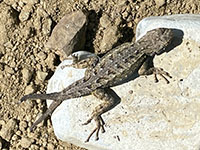 Fig. 2-37. Modern reptiles (like this western fence lizard) are descendant from Permian tetrapods.  Fig. 2-39. Map of the Permian Reef complex in the Permian Basin of West Texas and southern New Mexico. |
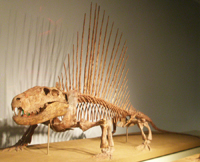 Fig. 2-38. Dimetrodon, a mammal-like reptile from the Permian Period on display at the Chicago Field Museum.  Fig. 2-40. Permian limestone reef track exposed in Texas and New Mexico, such as in Guadalupe Mountains and Carlsbad Caverns National Parks. Fig. 2-40. Permian limestone reef track exposed in Texas and New Mexico, such as in Guadalupe Mountains and Carlsbad Caverns National Parks. |
Evidence of Large Mass Extinctions Preserved In the Fossil RecordExtinction is the state or process of a species, family, or larger group being or becoming extinct (ceasing to exist).Extensive studies of microfossils in deep well cores extracted from around the world show that the appearance and disappearance (extinction) of species has happened continuously through geologic time, but the rate was not constant. As climates and landscapes changed, new species evolved to fit ever changing ecological niches; older species fade away. A mass extinction is an episode or event in earth history where large numbers of species vanish from the fossil record nearly simultaneously. The causes of mass extinctions are debated, but some are linked to possible global climate changes associated with asteroid impacts, massive volcanism episodes, onset of ice ages, or a combination of effects that affected environments globally. Many questions remain about the causes of the great mass extinctions (because they may shed light on what is happening or may happen to the world related to human activities impacting the modern environment). Current estimates are that 90 percent of all species that have ever lived on Earth are now extinct. However, the rate of extinction has not been constant. Mass extinctions have occurred at least five times in the last 500 million years. With each mass extinction much as about 50 to 90 percent of previously existing species on Earth had disappeared in very short periods of geologic time (Figure 2-41). Some mass extinctions are associated with great catastrophes associated with massive asteroid impacts that disrupted or destroyed ecosystems around the world (Figure 2-42). |
 Fig. 2-41. Great mass extinction events in the fossil record (species diversity compared with the geologic time scale). 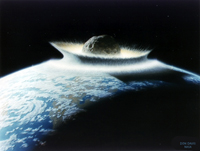 Fig. 2-42. An massive asteroid impact can ruin your day (and your species, and many others). 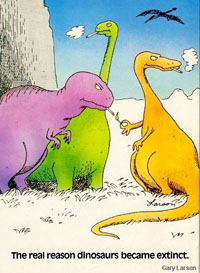 Fig. 2-43. A classic Far Side cartoon by Gary Larson about "the real reason dinosaurs became extinct." Fig. 2-43. A classic Far Side cartoon by Gary Larson about "the real reason dinosaurs became extinct." |
The Permian/Triassic (P/T) Boundary Extinction—The Greatest Of All Mass ExtinctionsThe greatest mass extinction event occur at the end of the Permian Period (about 252 million years ago). Most families of organisms that existed in the Paleozoic Era vanished at the end of the Permian Period. A 2008 report published by the Royal Society of London provided estimates that as much as 96 percent of marine species and about 70 percent of terrestrial vertebrates that existed in Late Permian time vanished during the end of the Permian extinction event. This occurred during the assembly and breakup of the supercontinent Pangaea. Great amounts of volcanism are known from that period associated with the rifting and opening of the Atlantic Ocean basin. However, other causes, such as glaciation, ocean circulation collapse, or possibly asteroid and comet impacts, extraterrestrial radiation events, and others have been pondered. The problem with studying mass extinctions like the one associated with the Permian-Triassic boundary is that the world has significantly changed since that time. Bedrock of Permian and older age under all the world's ocean basins have be subducted back into the Earth's mantle or heavily altered by mountain-building processes. In addition, much of the sedimentary record associated with exposed land of that time were stripped away by erosion before sediments began to be deposited and preserved in Triassic Period. Whatever the cause, it took many millions of years after the P/T extinction event (or events) for the biodiversity of the planet to return to levels that existed before in the Late Paleozoic Era. When this biodiversity returned, the world was host to completely different varieties of species and ecological communities, many replacing or occupying the same life habits (niches) and environments occupied by organisms that disappeared before the P/T extinction.Great extinction events created opportunity for new life-forms to emerge. For instance, dinosaurs and many other life forms appeared only after the mass extinction at the end of the Permian Period (about 252 million years ago). The same is true for when mammals replaced dinosaurs when they went extinct at the end of the Cretaceous Period. Perhaps the most studied extinction event has been the Cretaceous-Tertiary Boundary where strong evidence suggests at least one asteroid collided with earth in the vicinity of the Yucatan Peninsula in Mexico (about 66 million years ago)(Figure 2-41, also see Figure 2-58 below). This extinction killed off the dinosaurs and many other families of organism that lived in the oceans and on land. However, the catastrophe made room for mammals and other groups of organisms to rapidly diversify and evolve. Unlike the P/T extinction which has limited exposure around the world from 252 million years ago, there are many locations world wide and on all continents and within sediments extracted from the sea floor that reveal information about what happened at the end of the Cretaceous Period about 66 to 65 million years ago (discussed below). |
Are humans causing a sixth great mass extinction?Many scientists believe evidence suggests that another mass extinction is currently under way. Global climate change, the growth of the human population, and the expansion of human activity into previously wild habitats are largely to blame. Some estimates suggest that human activities such as land clearing (for agriculture), pollution, mining, urban development, and over fishing may drive more than half of the world's marine and land species to extinction possibly within the next century. This extinction event perhaps began during the end of the last ice age when humans spread around the globe and their populations expanded when the global climate was drastically changing. Many species of large land animals and birds have vanished in the past 10,000 years, but the rate of changes has drastically increased in the past 100 years with the tremendous expansion in the global human population. |
Mesozoic Era |
| The Mesozoic Era is the era between the Paleozoic and Cenozoic Eras, comprising the Triassic, Jurassic, and Cretaceous Periods. The Mesozoic Era is commonly referred to as the Age of Reptiles. Highlights of the Mesozoic Era include: • Dominant large animals: Reptiles and dinosaurs; birds and mammals appear. • Increased mountain building occurred in many regions around the globe, and with that, lots of sediments were generated from erosion. • The ancient supercontinent, Pangaea, begins to breakup at about 200 million years ago (Pangaea is discussed in Chapter 4). • With the breakup of Pangaea, continents began moving apart. This caused isolation of species and communities, and as a result, created more diversity in plant and animal species through divergent evolution. • The ancestral Rocky Mountains and Cordilleran Ranges formed in western North America between about 120 to 66 million years ago. |
Triassic Period (252 to 201 million years)Following the great extinction event at the end of the Permian Period, life on Earth gradually reestablished itself both on land and in the oceans through succession. Scleractinians (modern corals) replaced earlier forms as dominant reef-forming organisms. On land, reptilian therapsids (an order related to the distant ancestors of mammals) and archosaurs (ancestors of dinosaurs and modern crocodillians) became the dominant vertebrates. New groups evolved in the middle to late Triassic Period including the first dinosaurs, primitive mammals, and flying vertebrates (pterosaurs) but these families did not flourish until after another global extinction event at the close of Triassic time. Current thought is that ancestral forms of both mammals and dinosaurs first appear in the fossil record in Late Triassic time, about 200 million years ago (Figures 2-44 to 2-46). Petrified Forest National Park displays an abundance fossil plant and animal fossil associated with coastal swamp environments that were preserved in ancient volcanic ash beds. They are now exposed in the Painted Desert region of eastern Arizona and New Mexico, including in Petrified Forest National Park (Figure 2-47).During the middle Triassic, the supercontinent of Pangaea began to rift apart into separate landmasses, Laurasia to the north and Gondwanaland to the south. With the breakup of Pangaea, terrestrial climates gradually changed from being mostly hot and dry to more humid condition. Another mass extinction in the fossil record marks the end of the Triassic Period.
|
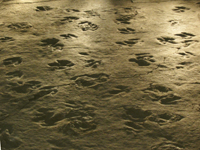 Fig. 2-44. Dinosaur tracks in Late Triassic sedimentary rocks, Dinosaur State Park, Connecticut.  Fig. 2-46. Placerias, a large mammal-like reptile from the Triassic Period from Petrified Forest National Park, Arizona. |
|
Jurassic Period (201 to 145 million years)The cause of the mass extinction at the end of Triassic is still unclear, but evidence shows that it was associated with rapid and massive amounts of volcanism that was taking place with the breakup of Pangaea (created by the opening of the Atlantic Ocean basin as North and South America gradually split away from the African and European continents).With other life forms out of the way, dinosaurs adapted and diversified into a wide variety of groups. Although pterosaurs were the dominant flying vertebrates during the Jurassic Periods, the first birds appeared—having evolved from a branch of theropod dinosaurs (Figures 2-49 to 2-51). Rare small mammals occur in the fossil record during the Jurassic Period, but remained insignificant compared to the dinosaurs that dominated the landscape. Large marine reptiles including ichthyosaurs and plesiosaurs dominated the oceans.
|
 Fig. 2-49. Dinosaur tracks in Jurassic-age rocks near Tuba City, Arizona. 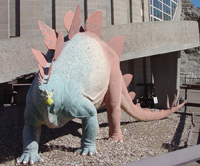 Fig. 2-51. Reconstruction of Stegasaurus, a Jurassic-age vegetarian dinosaur with unusual spinal plates. Dinosaur National Monument, Utah. |
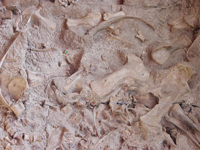 Fig. 2-50. Dinosaur bones preserved in ancient river bed sediments, Dinosaur National Monument, Utah. 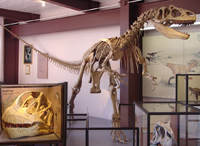 Fig. 2-52. Skeleton of Allosaurus, a massive carnivorous dinosaur from the Jurassic Period. Dinosaur National Monument, Utah. |
Cretaceous Period (145 to 66 million years)During the Cretaceous Period the Earth was relatively warm compared to the world today. There were no glaciers on the planet and sea level was as much as 200 feet higher that today. Fossils of warm-water organisms are found in rocks that are arctic regions today. The dinosaurs that survived into the Cretaceous Period diversified and evolved into many unusual forms. Large marine reptiles called Mosasaurs were the dominant organism in the ocean. Sediments deposited in shallow sea flooding onto the continents had an abundance of ammonites—squid-like organisms that had calcareous shells similar to modern nautilus species (Figure 2-54). Cretaceous gets its name for Creta—Latin for the word chalk. The shallow warm seas of the Cretaceous Period were locations where the calcareous skeletal remains of planktonic organisms called coccoliths accumulated, forming great accumulations of chalk, such as exposed in the Great White Cliffs of Dover, England (Figure 2-55). In many places in the equatorial realm oyster-like organism called rudists formed great reefs. Flowering plants also first appear in the fossil record, birds existed in Cretaceous time but were insignificant compared to flying non-avian pterosaurs. Some of the largest (and perhaps most familiar) dinosaurs appear in Late Cretaceous time (Figures 2-56 to 2-58). In contrast, small mammals first appear in abundance in the Cretaceous Period, but they were still generally insignificant compared with more dominant reptile and dinosaur species that existed around them.During Late Cretaceous time, a large mountain range and volcanic arc developed along the western margin of North America as the Atlantic Ocean basin began to rapidly expand. The rising mountains in the west forced an isostatic down warping of the central part of the North American continent resulting in the accumulation of massive sedimentary rock formations of the Zuni Sequence, as illustrated in Figure 2-59. This down warping eventually allowed the shallow Western Interior Seaway to expand and flood across much of the region extending from Arctic Ocean in Alaska and Canada to the Texas Gulf Coast region and throughout the Great Plains and Colorado Plateau regions (Figure 2-60).
|
 Fig. 2-54. Late Cretaceous ammonites of the Western Interior Seaway - an ancient seaway that existed in the Great Plains and Rocky Mountain region during Cretaceous Time. 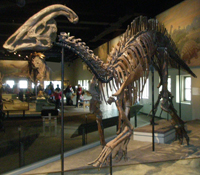 Fig. 2-57. Parasaurolophus- a Late Cretaceous dinosaur with a crested skull. |
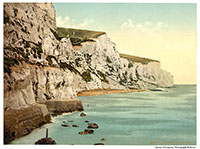 Fig. 2-55. Cretaceous-age chalk exposed in the White Cliffs of Dover, England.  Fig. 2-56. Triceratops, a Late Cretaceous herbivore dinosaur. Chicago Field Museum.  Fig. 2-58. Dinosaur Sue, a famous Tyrannosaurus rex fossil on display at the Chicago Field Museum. T. rex was a large carnivorous dinosaur of the Late Cretaceous Period. |
The Cretaceous-Tertiary Boundary (or K/T Boundary) ExtinctionThe Cretaceous-Tertiary (K/T) boundary [or Cretaceous/Paleogene Boundary (K/P)] is associated with one of the most investigated mass extinction events. The age of the K/T boundary is currently estimated to be about 66 million years based on absolute dating methods. It is has been well investigated partly because it is the youngest of the large extinctions that totally changed the nature of life on Earth. It is also well exposed in many locations on land around the world and has been studied extensively in core samples from deep-sea drilling projects.The K/T extinction event is believe to have been caused by a massive asteroid impact in the Yucatan region of Mexico, although other possible sites of large impacts are being considered. What is known is that all species of dinosaurs on land, and marine reptiles and ammonites in the marine realm vanished (Figures 2-61 and 2-62). The massive asteroid impact and following shock waves, monstrous tsunamis, firestorms, ash clouds, toxic gas clouds, and global winter-like condition that followed caused ecosystem collapse and failure of the food chains and webs in both the oceans and on land. It is important to note that all species that exist today are descendant of the limited number of species that survived the global catastrophe... small mammals, birds, invertebrates, reptiles, amphibians, fish and other surviving groups had evolutionary advantages that allowed them to survive. With the dinosaurs, pterosaurs, large swimming reptiles and other large animals of the Cretaceous Period out of the way, the surviving species proliferated and moved into empty and new niches that allowed them to prosper and diversify. The K-T boundary occurred near the end of the Zuni Sequence Cycle when sea level also fell around the globe (see Figure 2-13). The In the following Cenozoic Era many changes continued to occur including the uplift of the Rocky Mountain region and the withdrawal and disappearance of shallow inland seas and great lakes that previously flooded the Western Interior region. |
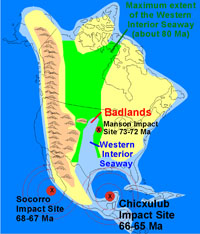 Fig. 2-60. Western Interior Seaway and locations of plausible asteroid impact sites around North America. |
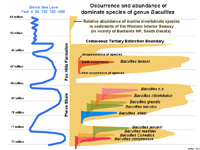 |
| Fig. 2-61. Appearance, expansion, decline and extinction of Late Cretaceous ammonite genus Baculites. Diagram shows changes in sea level and abundance of marine species. Ammonites disappear at the K/T boundary. | ||
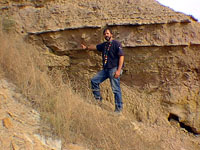 |
The person is pointing toward a zone of disrupted bedding that corresponds to the zone where many terrestrial and marine species vanished from the fossil record at the end of the Cretaceous Period. | |
| Fig. 2-62. A layer of highly disrupted sediments corresponds with the mass extinction horizon associated in marine sediments located along the Cretaceous-Tertiary extinction boundary exposed in and around Badlands National Park, South Dakota. | ||
Cenozoic EraThe Cenozoic is commonly referred to as the Age of Mammals. The Cenozoic Era began with the mass extinction event associated with the K/T Boundary (discussed above). Highlights of the Cenozoic Era include:• Dominant large animals: Mammals. Mammals diversified, gradually replacing the niches held by dinosaurs wiped out by the K/T extinction. • Mountain building continued, especially around the Pacific Ocean; the Himalayan Mountains, the Alps, and mountain ranges throughout southern Eurasia begin to form. The Rocky Mountains and Cordilleran Ranges in western North America continued to form. • Lots of erosion of existing mountains fed sediments to coastal plains and ocean margin basins. • The youngest Tejas Sequence began to accumulated in the early Cenozoic Era and continues to the present day, forming the Atlantic and Gulf Coast regions.
The older name, Tertiary Period, in now subdivided into two periods: Paleogene Period and Neogene Period. The periods of the Cenozoic Era are also subdivided into time periods called epochs. |
|||||||||||||||||
Paleogene Period (66 to 23 million years ago) |
Period |
Epoch |
Notes |
Time Range |
| Paleogene | Paleocene Epoch |
The mass extinction at the end of the Cretaceous Period left many of the niches filled by dinosaurs and large swimming reptiles empty. Mammals with placental-type live birth appear. Shallow seas of the Cretaceous period withdrew or were gradually replaced by lakes. In North America, the Rocky Mountains began to rise. See more about the Paleocene: American Museum of Natural History | 66 to 56 million |
Eocene Epoch |
Modern-like forms of mammals appear and diversify in the fossil record during the Eocene Epoch. The Eocene was a warm period with an expanded tropical realm. The end of the Eocene period is marked by a mass extinction that may have involved asteroid collisions in Siberia and in the vicinity of Chesapeake Bay. See more about the Eocene: American Museum of Natural History | 56 to 33.9 million | |
Oligocene Epoch |
The Oligocene was a time of transition when older life forms were replace with life forms that dominate the world today. The warmer, more tropical environments of the Eocene Epoch gave way to dryer landscapes dominated by grasslands, whereas broad-leaf forests became more restricted to the equatorial realm. See more about the Oligocene: American Museum of Natural History | 33.9 to 23.0 million |
| Figures 2-63 to 2-66 are selected examples of locations where Paleogene-age sedimentary rock formations are exposed and have been investigated in the United States. There are many other famous locations throughout the Atlantic and Gulf coastal plains and throughout the western United States. |
|
Neogene Period (23 to 2.6 million years ago) |
Period |
Epoch |
Notes |
Time Range |
Neogene |
Miocene Epoch |
Animals and plants of the Miocene Epoch are approaching modern life forms in diversity and appearance. Earth was warmer with expanded tropical realms compared to the modern world. The Himalayan Mountains begin to rise as the Indian continental landmass began to collide with Asia. See more about the Miocene: American Museum of Natural History | 23 to 5.3 million |
Pliocene Epoch |
Global climates cooled and became dryer with the onset of glaciation cycles. Most families of animals and plants found in the world had ancestral forms during the Pliocene, including humans. Greenland's ice sheet starts to form. South America and North America became linked at the Isthmus of Panama, allowing the cross migration of many species between continents; but also shutting off the migration of species from the Atlantic to the Pacific oceans. The same kind of interactions took place when Africa collided with Europe. See more about the Pliocene: American Museum of Natural History | 5.3 to 2.6 million |
| Figures 2-67 to 2-70 are selected examples of locations where Neogene-age sedimentary rock formations are exposed and have been investigated in the United States. There are many other famous locations throughout the Atlantic and Gulf coastal plains and throughout the western United States. |
|
Quaternary Period (2.6 million years ago to Present) |
Period |
Epoch |
Notes |
Time Range |
Quaternary |
Pleistocene Epoch |
Time period of major ice ages where continental glaciation advance and retreated; glaciers covering much of northern North America and Europe during cold periods. Modern human species appears in the fossil record. Many species of large land mammals went extinct at the end of the Pleistocene Epoch. Learn more about the Pleistocene of California preserved in the La Brea Tar Pits, Los Angeles (UC Berkeley Museum of Paleontology website). | 2.6 million to 11,000 years |
Holocene Epoch |
End of the Wisconsinian ice age to the present. Includes a 400 foot-rise in sea level and the rise of human civilizations. Humans rise to become the dominant species on Earth. Learn more about the Holocene: American Museum of Natural History | 11,500 years to present |
| Figures 2-71 to 2-74 are selected examples of locations where Quaternary-age sedimentary rock formations are exposed and have been investigated in the United States. There are many other famous locations throughout the Atlantic and Gulf coastal plains, in and around ancient lake basins throughout the western states, and throughout the glaciated regions of the Midwest, Great Lake and New England regions where continental glaciers once covered the landscapes. |
|
Evolution of Humans and the Rise of Modern Civilization |
|
Some 15 to 20 different species of early human-like species (humanoids) are currently recognized. However, not all scientists studying human evolution agree how these species are related or how or why they died out. The majority of early human species left no living descendants. Scientists also debate over how to identify and classify particular species of early humans, and about what factors influenced the evolution and extinction of each species or sub-species. Humans are included in the family of primates (which include modern monkeys, apes, and humans). Primates are descendant from an earlier monkey-like group called prosimians that appear in the fossil record in Eocene to Oligocene time. Primate species appear in abundance in many locations around the world during the Miocene Epoch (between 23 to 5.7 million years ago). Fossils of earliest recorded human-like ancestors come from sediments of 6-7 million years ago in western Africa; the species had chimpanzee-sized brains and were able to walk upright on two legs. Fossils of 6 to 3 million years recovered in eastern Africa (Ethiopia) show species with ape-like features that walked upright and lived in forested environments. By 4 million years ago, early human species lived in near open areas in forested environments; bone structures show they were able to walk upright (bipedal) and still climb trees. The famous Lucy skeleton (about 3 million years show species had ape-like proportions of face, brain case, strong arms [for climbing], but walked upright on arched feet. The oldest stone tools have been found in sediments deposited 2.6 million years ago. Homo habilis (2.4-1.4 million years ago) species thought to represent the first stone toolmaker. Multiple species of the genus Homo have been discovered from the time period of about 2 to 1 million years ago; some sharing the same environments. Human use of fire began about 800,000 years ago. Evidence suggests fire was used for warmth, cooking, socializing, and safety from predators. Homo erectus is known from ages about 1.89 million to 143,000 years ago, and fossils have been recovered from places as distant as eastern to southern Africa; western Asia (Republic of Georgia), China and Indonesia. The species used fire and ate meat, and evidence suggest that they took care of old and weak members of their clans. A rapid increase in human brain size took place from 800,000 to 200,000 years ago, giving humans better survival skills the ability to adapt to changing environmental conditions (such as the onset of ice ages and interglacial warm and dry periods). Our species, Homo sapiens, first appear in the fossil record about 200,000 years ago in Africa, but spread out into Europe and Asia by at 100,000 years ago (Figure 2-75). We now inhabit land everywhere on the planet and we are the sole surviving species of a once diverse group of ancestral family of human-like species. As human populations spread around the world, populations became isolated and developed characteristics associated with major races of humans that exist throughout the world today. Climate change associated with the ice ages must have had significant impacts on the survival and extinction of human and human-like species. In addition, populations were impacted by massive volcanic episodes, such as the by the Toba Super Eruption in Sumatra that occurred about 75,000 years ago. Although new discoveries are constantly being made, current though is that humans first came to Australia within the past 60,000 years and to the Americas within the past 30,000 years. Use of agriculture methods and the rise of the first civilizations developed within the past 12,000 years. As the human species has expanded, diversified, adapted, and populated. In contrast, many other species have already gone extinct due to human predation, isolation, and habitat destruction. The modern human population has benefited from advances in medicine, agriculture, and transportation. The world's population has doubled in the last 40 years, but the rate of population growth has declined by almost half in that time (but not enough to stop population growth)(Figure 2-76 to 2-77). However, this success is countered by the demands of land and resources that lead to war and conflicts between populations. Population growth is not evenly distributed around the world (Figure 2-78). |
 Fig. 2-75. Routes of human evolution and migration around the world beginning in late Pleistocene time.  Fig. 2-76. Within the past century, human activity has completely changed large regions of the planet's physical environment. Fig. 2-76. Within the past century, human activity has completely changed large regions of the planet's physical environment. Fig. 2-77. World population growth 1600 to 2017 and rate of population growth 1950 to 2017 from United Nations data. Fig. 2-77. World population growth 1600 to 2017 and rate of population growth 1950 to 2017 from United Nations data. 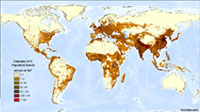 Fig. 2-78. World population density map of the world for 2015. Note that large populations have developed in regions of high agricultural productivity where water is abundant (and perhaps the most valuable resource to a region). Fig. 2-78. World population density map of the world for 2015. Note that large populations have developed in regions of high agricultural productivity where water is abundant (and perhaps the most valuable resource to a region). |
What Does It Mean To Be Human? (Ancestral Human Evolution, Adaptations, and Behavoir)Check out the Smithsonian Institution's National Museum of Natural History website on human evolution (https://humanorigins.si.edu/). This is a comprehensive website that reviews human evolution research, evidence (including human fossils, tools, genetics, geochronology dating, and fact-based interpretations).Human Evolution Time-line Interactive (Smithsonian Institution website) http://humanorigins.si.edu/evidence/human-evolution-timeline-interactive |
Refugia: How Life Goes On After Environmental CalamitiesEven after any number of the great mass extinctions, life returned and flourished in abundance. Once the environmental calamity that caused the great mass extinction at the end of the Cretaceous Period ended, this allowed for the succession of living things from life forms that survived in place, or survived in refugia. A refugia is an area in which a populations of organisms can survived during an extended period of unfavorable conditions. Refugia are isolated or protected environmental setting that survive major climate changes—examples include:• an unglaciated area on a south-facing mountain slope where plants and animals survive in isolation, surrounded by advancing continental glaciers. • species surviving an isolated mountain peak cool and wet enough to allow some species to survive when surrounding lowlands change from forests to desert conditions. • plants and animals that become isolated on islands when sea level rises, and relative species elsewhere are wiped out by disease and/or predation. • a an isolated community surviving in a canyon with continuous water supply in a region of long-term extended drought. • species living in an isolated bay far away from the annihilation caused by a massive asteroid impact elsewhere on the planet. Many question remain why some species survive a mass extinction event. What was it about species turtles, snakes, crocodillians, birds, and mammals that allowed them to survive the K/T extinction event when all dinosaurs and other organisms did not? Refugia In Our Modern EraWith the advance of human civilizations, we are witnessing unprecedented extinctions as cities and croplands replace forests and coastal plains. Some species are hunted to extinction, or environmentally sensitive species loose their refugia. Human activities, such as building interstate highways and expansion of urban corridors, are isolating populations that would otherwise be a part of a continuous breeding population across an area or region. For some species, surviving member of species now only exist in zoos or on isolated park lands and wildlife preserves. On the other hand, useful species, such as dogs, cats, goats, cows, chickens, etc., are protected, but are increasingly being genetically modified to suit the needs and interests of their human hosts. |
Evolution and Adaptation To ExtremesAdaptation is the driving force of evolution on many levels (microscopic to massive organisms; individual species to diverse communities). Environmental changes over time force species and communities (ecosystems) to adapt to special niches. Figure 2-79 shows the evolution and diversification of plants through geologic time. Some species able to spread across large regions by adapting to variable climate conditions that match their reproductive and feeding cycles. Ancient lineages that have survived extinction are often better adapted to living in harsh environments (such as lichens, mosses, and club mosses living in barren, rocky settings, Figure 2-80). Species like the Giant Sequoias that live in isolated communities in California's Sierra Nevada Range are remnant populations was once a much more widespread forest community that existed during the last ice age (Figure 2-81).Organisms that have adapted to living in vernal pools illustrate adaptation to extreme environmental conditions. A vernal pool is a small pool or pond that forms temporarily, such as after a summer thunderstorm, seasonal precipitation (Figure 2-83). During a short period when water is present, a variety of species have adapted to completing their entire life cycle in a matter of days to weeks before the water dries up or becomes too salty. Amazingly, species like tadpole shrimp, fairy shrimp, and other desert species have adapted to these extreme environmental conditions. Tadpole shrimp have fossil ancestry dating back to marine environments in middle Paleozoic time. Tadpole shrimp have basically survived longer than any known species by being able to adapt to a variety of extreme environment conditions (Figure 2-84). |
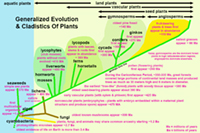 Fig. 2-79. Evolution involving competition and adaptations have led to a diversification of plants and mold through geologic time. |
 Fig, 2-80. Ancient lineages of early plants (such lichens, mosses, and club mosses) have adapted to harsh environments on rocky settings. |
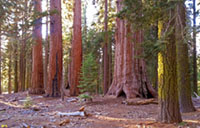 Fig. 2-81. Giant Sequoias (the world's largest trees) in Yosemite National Park, CA are adapted to local climate conditions. |
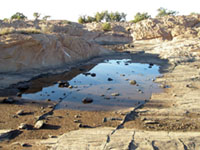 Fig. 2-82. Vernal pools like this one form in after a desert summer thunderstorm. Within days, species such as tadpole shrimp hatch, feed on limited food supply, grow to adult size, reproduce (producing cysts and eggs, both sexually and asexually) before dying off when the water dries up, sometimes for many years between periods of precipitation. |
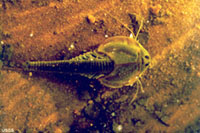 Fig. 2-83. Tadpole shrimp are brachiopod crustaceans that appeared in the marine fossil record about 400 million years ago, but are only found today in vernal pool habitats. Their body plan has remained more or less consistent over the course of the past 250 million years. These species have adapted to survive some of the harshest climate extremes on Earth. |
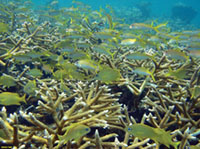 Fig. 2-84. Healthy coral reef communities are adapted to a stable yet limited range of environmental conditions: clear, shallow, warm seawater with good circulation. Today, reef communities worldwide are threatened by rapidly changing environmental conditions largely influenced by human activities (pollution, heat from global warming, and resource exploitation). |
| Modern Coral Reefs: Massive coral reef are found along the margin of continents and islands in tropical marine setting around the world (Figure 2-84). The Great Barrier Reef along the eastern coastline of Australia is perhaps the largest accumulation of biogenic material on the globe, formed from the accumulation of debris from rapidly growing coral communities. These reefs have grown, filling in coastal areas as sea level has risen nearly 400 feet to it present level from the peak of the last ice age, about 18,000 years ago. The big questions is how will they continue to grow and adapt with climate change? |
The Anthropocene Epoch (1865 AD to present)?The name Holocene Epoch has been applied to the time period extending from the end of the last ice age, encompassing the rise of human civilizations up to the present time. However, the name Anthropocene has been suggested to designate the current geological age, viewed as the period during which human activity has become the dominant influence on climate and the physical environment. Some question are: When did this happen? And, how will generations of consciously aware descendants of our times (human and otherwise) be able to recognize it from landforms and layers with sedimentary deposits? Many suggestions have been made, and deposits in one region may not completely match characteristics in another region. (This is an excellent discussion topic for examining other extinction boundaries in the geologic past!) Here are points to consider: when did the Anthropocene begin?• Many scientists think the beginning of the Anthropocene began with the Industrial Revolution in the 1850s; the logical start starting point to the modern era. The start of the Industrial Revolution marks when major extraction of mineral resources began (coal, iron, and other metals), the spread transportation networks, the growth and expansion urban development (Figure 2-85). • Durable pollen from eucalyptus trees imported from Australia and New Zealand to support expansion or the railroads start to appear in sediments throughout California sedimentary basin deposits starting in the 1850s. • Mass production and distribution of durable glass, porcelain products, and lead bullets started in the 1850s, beginning the contribution to throw-away society materials that can be found in abundance wherever humans went. Durable man-made products began to accumulate as trash in the environment. A later start to the Anthropocene Epoch is suggested for post World War II. Sediments from this period include: • A universal boundary world-wide where radioactive isotopes and byproducts of the surface testing of nuclear weapons can now be identified as a boundary in sedimentary deposit around the world. • Durable plastics, construction materials, porcelain tiles, composite materials, and other durable trash of the modern era released intentionally or accidentally (such as damaging effect caused by superstorm damage, tsunamis, floods, or other disasters) are now distributed throughout the environment. • Construction of sprawling urban area, mining regions, transportation routes (such as interstate highways) , and agricultural activities have significantly modified the landscape in many regions that will have lasting effect on the landscape for many millennium into the future. Some estimates suggest that human activities are moving more materials than all the rivers, wind, ocean currents, and other natural geologic processes combined. • Landfills will be a long-lasting time stamp on the landscape worldwide. • Introduction of exotic species have completely changed the environment in many regions. This discussion has many intriguing manifestations. Can humans organize and adjust to what might be considered sustainability? Or, perhaps without hope, are we destined to an apocalyptic fate as describe by Thomas Malthus (1766-1834), an English economist and demographer who proposed a theory that human population growth will always tend to outrun the food supply. Malthus suggested that the betterment of humankind is impossible without strict enforcement of limits on reproduction. So far in our modern era, it seems that some of the limitations on what might be considered sustainable have been addressed by advancing technology and changing social norms (globally). The question is, can we collectively achieve sustainability without enduring war, disease, and famine? |
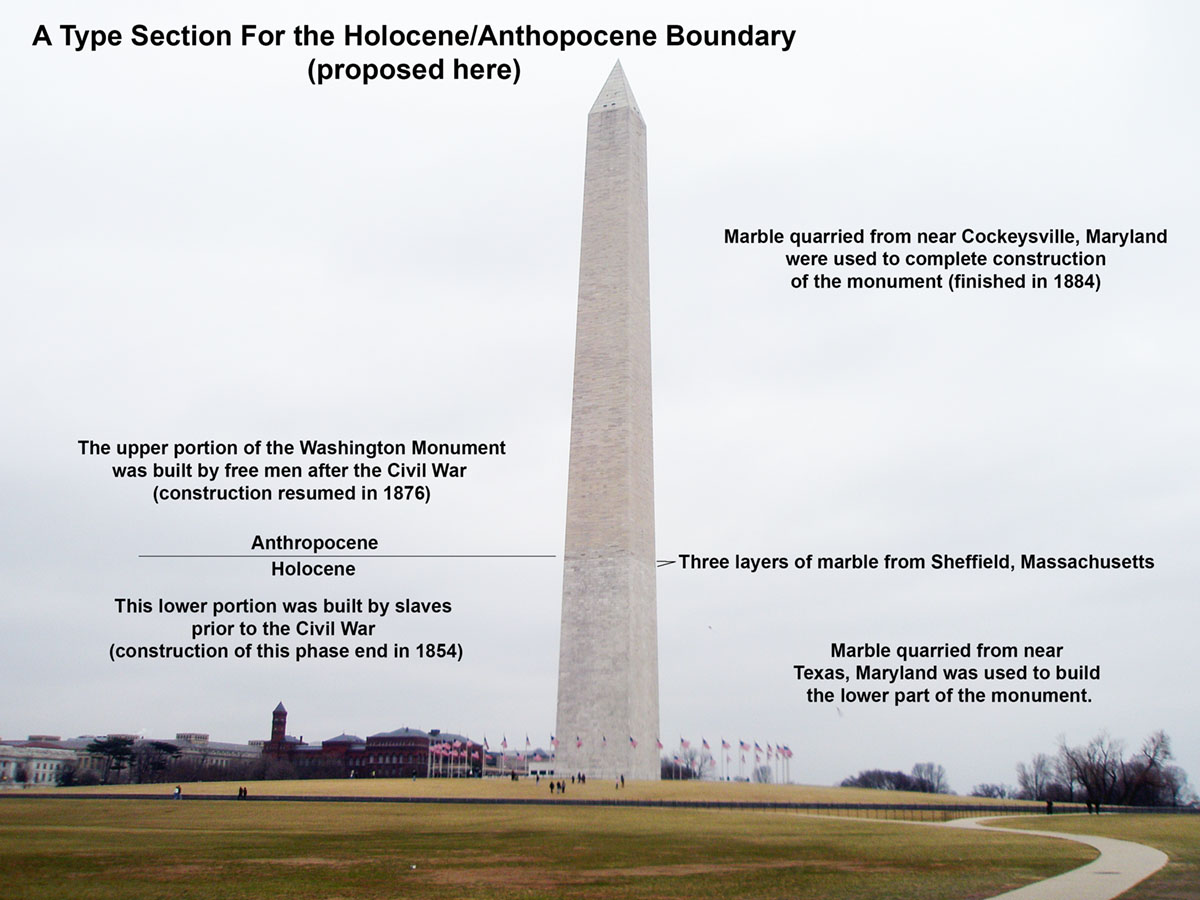 Fig. 2-85. The Washington Monument is a possibly a good choice for a type section for the Holocene/Anthropocene Boundary. The lower part of the monument was built (by slaves) before the Industrial Revolution began. The upper part of monument was completed in a second construction phase after the Civil War (by free men) after the Industrial Revolution was well in progress. Interestingly, the H/A Boundary level depicted on the Washington Monument approximately marks the level that sea level will rise to if most of the ice on Greenland and Antarctica were to melt due to global warming (as has already occurred in the geologic past). |
 |
Fig. 2-86. A famous cartoon depicting human evolution. Many people agree that humans are greatly altering our global environment with potentially catastrophic consequences without drastic changes in how we use our planet's limited resources. We need to learn how to manage and sustain our world's natural resources and manage our populations in any way while avoiding catastrophe. |
Concepts of evolution, refugia, and succession provide a valuable lesson about modern society.In our life times we can witness the progress of evolution in many ways, and hopefully, learn. The advance of technology illustrates these concepts. Classic examples illustrate:• cars and displacing or replacing trains and horse-drawn carts as primary means of transportation. • cell phones replacing telephones, which replaced telegraphs and mail services as primary means of communication. • cable television replacing radio/TV broadcasting. • cities grow through succession following the changes in politics, industry, and development of infrastructure. So, should calamity happen, and an area or region should loose electrical power or access to liquid fuels, what would survive? Populations would need to migrate, adapt, or face famine. Electric- and gas-power tools and equipment would be rendered useless, but hand-powered tools like hammers, water pumps, shovels, saws and axes would be increasingly valuable! In the business world, evolution provides particularly important concepts. It is an interesting study to see how businesses and corporations survive economic calamities caused by wars and depressions, and the rise of competing new technologies. It is a jungle out there. |
Where are rocks of different geologic ages exposed in the United States?Rocks of all geologic ages are exposed in different parts of the United States. Figure 2-87 is a geologic map of the conterminous United States, and Figure 2-88 is the geologic map legend that shows colors associated with regions where rocks of different ages are exposed at the surface. Earth scientists use geologic maps like these to locate areas where they may go study the fossil record where rocks of different ages (and the fossils they contain) occur. Each region of the country has unique fossil record. The best place to start an investigation is to visit museums, universities, and government organizations that host fossil and rock collections in the vicinity where rocks are exposed. Learn more about the regional geology and natural resources of the United States on this link: Regional Geology of the United States. |
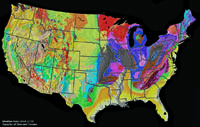 Fig. 2-87. Geologic map of the United States. |
 Fig. 2-88. Geologic ages of bedrock on the geologic map. |
| Selected comprehensive websites for paleontology and evolution: U.C. Berkeley Museum of Paleontology website http://www.ucmp.berkeley.edu/exhibits/index.php American Museum of Natural History https://www.amnh.org/our-research/paleontology Smithsonian Institution, Department of Paleobiology http://paleobiology.si.edu/ |
| Chapter 2 quiz questions |

